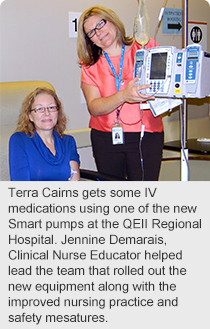
January 24, 2014
Story and Photo by Mark Evans
Terra Cairns used to spend up to five or six hours at the QEII Regional Hospital getting the intravenous (IV) medications she needed. Now, with the new IV SMART infusion pumps at the hospital, she is in and out in a couple of hours.
The new pumps are an integrated system that accurately delivers multiple medications effectively shortening the amount of time Cairns spends in the outpatient IV therapy area at the hospital.
“You feel really safe with it. You know the staff feel more confident that the machine is doing what they need it to do,” says Cairns.
The implementation of the new pumps in September was the result of months of preparation involving a team that included clinical engineering, pharmacy and nursing education playing a key role and worked closely with frontline staff, physicians, information technology and other groups to make the change seamless for patients.
“It was a team effort that embraced the new equipment and all the clinical practice changes that came with it,” said Jennine Desmarais, clinical nurse educator who helped lead the project. “Staff could see the changes were going to make a difference directly to the patient so we had a high level of support.”
The rollout involved 169 new pumps replacing the previous models. There was a total of 530 staff needing training and by the go-live day 455 of the staff were trained. The remaining staff received one-on-one training or took part in the ongoing training.
The rollout also wasn’t simply a process of switching out existing pumps for the new models, explains Desmarias. New guidelines were developed, improvements to clinical practice were implemented, updates to staff education and training resources were completed and the QEII became the first facility in Alberta to implement the new provincial AHS standardized drug concentrations.
The new pumps have a custom-built computerized library of all the drugs as well as preprogrammed drug doses and rate limits. Staff can select a pre-populated drug from the library and access a selection of administration options that have built in safety features. The old pumps had had handful of medications programmed and there no were preprogrammed limits.
The new pumps also have the capacity to be wirelessly updated. This allows for the libraries to be frequently revised and maintained with current drug settings. The old pumps had to be updated manually, one at a time, by clinical engineering if a program was added or changed.
Registered Nurse Karlin Lawrance in Intensive Care Unit (ICU) welcomed the practice changes and the new equipment. The additional safeguards help her provide safer care to her patients.
“It ensures you are doing your double and triple checks when you are giving medication,” says Lawrance. “You always do your triple checks but this is an interactive check with the pump.”
One of the many clinical practices implemented as part of the roll out was the provincial Line Labeling and Tracing policy. This policy ensures all IV lines are labeled and traced prior to administering of any medication or fluid. That’s especially important in the ICU where a patient can have eight or more medications at one time and there can be a lot of lines and IV bags of medications for one patient.
“There will be fewer medication errors,” says Lawrance. “It’s safer now for patients to be hooked up to a pump because it is checking what the nurse is doing.”
The new pumps also support ongoing learning and improvement, says Cindy O’Flaherty, clinical coordinator in the ICU. Staff must now scan a barcode on their identification badges to gain access the pumps control so in addition to preventing family, visitors or patients from adjusting the pump, it records when and who made what adjustments.
That allows the quality assurance team to identify any issues with the drug libraries, any nursing practice changes or improvements needed or where additional staff education is needed to continue to provide quality patient care.
“For the patient, the new pumps mean we have a system that is based on best practice and includes more safety checks and more standardization,” said Christopher Dolan, pharmacy manager northwest who was also involved in leading the project. “That means it is less likely that a patient will experience a medication error and the data collected will help in the prevention of future errors.”